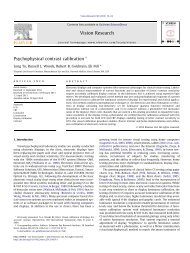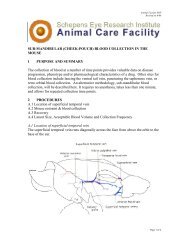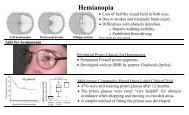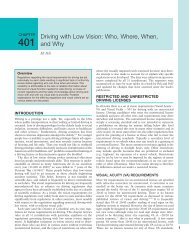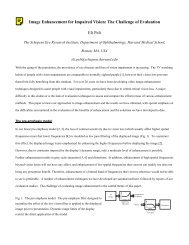In-the-Spectacle-Lens Telescopic Device for Low Vision
In-the-Spectacle-Lens Telescopic Device for Low Vision
In-the-Spectacle-Lens Telescopic Device for Low Vision
Create successful ePaper yourself
Turn your PDF publications into a flip-book with our unique Google optimized e-Paper software.
implements a magnifying element similar to that used in <strong>the</strong> in-<strong>the</strong>-lens electronic displaydeveloped by MicroOptical Engineering Corp 39 . Light entering <strong>the</strong> carrier lens at <strong>the</strong> objectivewindow on <strong>the</strong> left (Fig. 10) is reflected by <strong>the</strong> first beam splitter towards <strong>the</strong> concave mirror to<strong>the</strong> left (<strong>the</strong> objective). Following reflection and convergence at <strong>the</strong> concave mirror <strong>the</strong> lightpasses to <strong>the</strong> right through <strong>the</strong> beam splitter traveling through <strong>the</strong> carrier lens, <strong>for</strong>ming anintermediate image plane, and proceeding through <strong>the</strong> second beam splitter. It reflects off <strong>the</strong>second spherical concave mirror (<strong>the</strong> ocular), and is <strong>the</strong>n reflected by <strong>the</strong> second beam splitterinto <strong>the</strong> wearer’s eye. This arrangement provides a Keplerian (astronomical, reversing) telescopewith significant light loss due to <strong>the</strong> 4 passes through <strong>the</strong> beam splitters. Four such passes willresult in loss of 15/16 (94%) of <strong>the</strong> entering light.Quarter-wavePlate (λ/4)PolarizingbeamQuarter-wavePlate (λ/4)tPlano Convex lensBack side mirroredCarrier lensOccluderPlano Convex lensBack side mirroredFigure 10: A schematic of a Keplerian (astronomical- reversing) in-<strong>the</strong>-lens telescopeusing spherical mirrors, polarizing beam splitters and quarter wave plates.The light loss can be substantially recovered using polarizing beam splitters and quarterwave plates (Fig. 10). The first polarizing beam splitter that reflects only <strong>the</strong> S-componentresults in a 50% loss of light. Following reflection in <strong>the</strong> objective curved mirror and passingtwice through <strong>the</strong> quarter wave plate <strong>the</strong> reflected light will be polarized appropriately to passalmost unaffected through <strong>the</strong> polarizing beam splitter. Assuming <strong>the</strong>re is no change in <strong>the</strong>polarization state of <strong>the</strong> light as it travels through <strong>the</strong> carrier lens, it will pass through <strong>the</strong> second17




